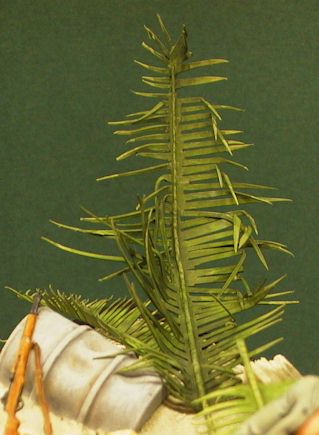model by Andreas Herbst
text and images by Martin Waligorski
Once in a while I see a model at a show which besides the admiration for the fine workmanship stirs up some deeper emotions the way that art can do. It happens with figures, vignettes and dioramas more often than with vehicle models, I guess depending on the viewer’s ability to relate to human element. Perhaps someone rightfully called diorama ”the definitive form of scale modelling”. This time I’d like to present a vignette by Andreas Herbst which to my mind falls into this fine category.
This little vignette depicts a hypothetical incident under the battle of the Peleliu atoll in September 1944. A Marine cannot withhold frustration over the fall of his comrade and bursts out in a berserk attack out towards the enemy, other soldiers jumping ahead to stop him.
Like other island invasions in the Pacific before it, Peleliu was a fight to capture an airfield on a a few tiny islands in the western Pacific. But the Peleliu turned out to be different in a way no one before anticipated. Here the Japanese defenders applied new, extremely determined strategy devised to make the invaders pay the highest possible cost in blood and time to achieve their objectives. A deep defence system was prepared all over the island, including blockhouses and concrete structures above ground, existing caves and tunnels under the jungle, ambushes and booby traps. It would make the invaders pay dearly for every chunk of coral taken.
Peleliu turned out to be one of the bloodiest battles of the Pacific War, costing the US Marines and Navy over six thousand casualties and stretching their combat ability and heroism to the utmost. It took almost 30 miserable, frustrating days to gain control over the island, and five more weeks to silence the last isolated Japanese hold-out positions. More still, the parallel success of the US forces at Leyte rendered the entire Peleliu campaign useless.
The Vignette
Andreas started this project by planning the vignette – its composition and characters, looking for a dynamic rather than static scene, which would wake reflection on the dark side of war – the terror, the despair and the human cost.
As all the main characters had to play together closely to create the sense of action, Andreas knew that any commercial figures used would require conversion to some degree. Nevertheless, the wide availability of 1/35 figures and accessories set the scale for the diorama.
Andreas selected the figures carefully, playing with different combinations and trying to limit the amount of conversion work required. He ended up with one figure each from Warrior, Verlinden, Dragon, Preiser and Historex – and still, as it turned out later, excessive conversions. All heads were replaced with new ones from Hornet, with one exception – that of the unfortunate berserk private who received his head from the Jaguar range. Altered clothing details, like part of his tunic held by another man’s hand, were sculpted from Milliput.
The most complex conversion work was done with the fallen soldier figure. He has a torso from Preiser, Hornet head and scratchbuilt lower body, arms and clothes.
All faces and skin parts of the figures were brush-painted with artists’ oils.
With the skin parts ready, Andreas used Humbrol enamels for the clothes, boots, helmets and weapons.
Moving on to the base, the palm tree trunk which forms a diagonal axle of the scene has been formed from Milliput. The leaves were cut and assembled from thin Plasticard.
The ground was first shaped in a layer of Milliput. The sand ”dunes” were then added from Green Putty, softened with liquid glue to allow forming that flowing shapes with a brush. Several items which were to be partially buried in the sand surface, like the sandbags (also sculpted from Milliput), the trunk, plus an occasional barrel and ammunition crate, were pressed into the base at this stage.
The base was allowed to dry, then brushed with glue once again and sprinkled with fine wood sawdust to simulate dry sand. The base was then airbrushed with Tamiya acrylics.
Detail items were hand-painted with Humbrol enamels and artists’ oils. Andreas used washes and dry-brushing to emphasize textures and detail on items like ammo crates, the tree trunk and the barrel. Dry pastels also found their use as a finishing medium.
This article was originally published in IPMS Stockholm Magazine in August 2004.











